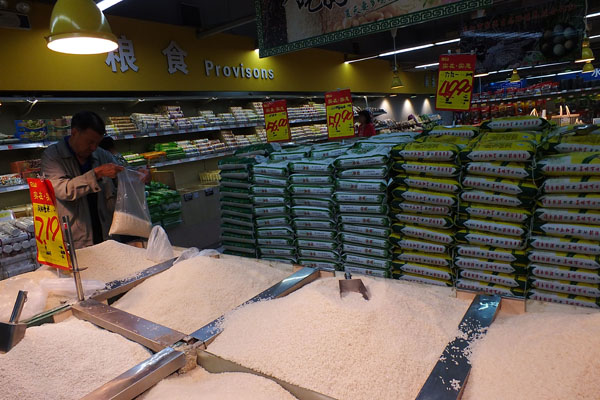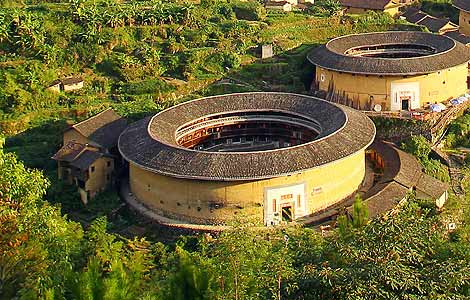Weather bears down on rice
Updated: 2013-08-14 00:10
By ZHONG NAN (China Daily)
|
|||||||||||
2013-14 import quota set at 5.3 million tons
Drought, heat, heavy rain and floods in China's major rice-growing regions are likely to cut the country's harvest and increase reliance on imports, industry experts have forecast.
An ongoing drought has harmed rice crops in Central and East China's major rice-growing regions such as Hunan and Jiangxi provinces.
 |
|
A shopper buys rice in a supermarket in Yichang, Hubei province. The bad weather that hit China's major rice-growing regions is likely to drive up imports in the world's biggest rice buyer.Liu Junfeng / For China Daily |
Meanwhile, heavy rain and floods have hit Heilongjiang province in Northeast China.
In addition, a heat wave has scorched 13 provincial-level areas and left about 6 million people and 1.72 million head of livestock short of drinking water, the Ministry of Civil Affairs said.
According to the State Flood Control and Drought Relief Headquarters, more than 1.87 million hectares of farmland have been affected by the drought in Hunan, Hubei and Jiangxi provinces. About 70 percent of the land involved is planted with rice.
Rain of medium to heavy intensity has continued battering Heilongjiang province, where it has flooded 5,300 ha of rice farmland.
Ding Lixin, a researcher at the Chinese Academy of Agricultural Sciences in Beijing, said the central government had set a rice import quota of 5.32 million tons for 2013-14.
Ding said the rough weather may boost actual rice imports to between 2.8 and 3 million tons this year alone.
China imported 2.36 million tons of rice from international markets such as Thailand and Vietnam in 2012.
"August is an important month for paddy rice to develop, when it needs more water and nutrients to grow. The drought will certainly cut yields and disrupt plans for late planting in South China," Ding said.
Sun Hongrong, who operates a family farm in the suburban Shanghai district of Songjiang, said high temperatures have been a headache since July.
Although his rice-planting area doubled this year to about 13 ha, Sun estimated that output will shrink 15 to 20 percent this year. Harvesting is due to start in about 20 days.
"For good-quality rice, the best temperature for pollination is about 32 degrees Celsius. But the reality in Shanghai is a temperature above 38 degrees Celsius for more than a week," said Sun.
The heat has also pushed up his costs for irrigation and labor.
Rice is different from corn or wheat, in that several countries such as the United States, Canada and Argentina are big producers of the latter grains. The world's other major rice-growing nations are mainly in Asia, such as Laos, Vietnam, Thailand, India and Indonesia.
"The problem that China must contend with is that these countries have limited land and production capacity in comparison with China."
"China might confront a severe situation if the rice output in these Asian countries was cut by natural disasters" or other developments, said Zheng Dawei, a professor at the China Agricultural University in Beijing.
China is the world's biggest rice importer. The Food and Agriculture Organization of the United Nations has forecast that the country's rice imports will reach 3 million tons, about 8 percent of the total global rice trade, in the 2013-14 crop year.
The country already imported about 1.32 million tons of rice in the first half of 2013, up about 12 percent from a year earlier.
China's National Meteorological Center has said that the heat wave will last only until the middle of August. But the drought may persist until the end of the month, because rain forecast for the final 10 days of the month may prove insufficient.
To tackle the drought, the government has allocated 1.65 billion yuan ($269.5 million) for the exploration of ground water sources, artificial rainmaking, building new water conservation facilities and other relief efforts.
"The impact of the drought on rice output in South China may be limited because the northeastern regions, rather than the south, have become the top contributor to the nation's grain harvest in recent years," said Li Guoxiang, a rural development researcher at the Chinese Academy of Social Sciences.
"However, if the floods in the northeast continue, it will have a worse impact on this year's rice output," Li said.
The adverse weather conditions have triggered concerns that the grain market will be the target of domestic and international speculators.
Li said domestic rice prices won't show a broad-based rise, even if China fails to achieve a second harvest this year, because the global supply-demand equation is balanced. China can adjust by resorting to the international grain markets.
"Grain stocks in China are at a high level, which also weakens the possibility of capital speculation on rice," Li said.
Today's Top News
Printed bones
Holding onto history
Dutch Prince Friso dies after 2012 avalanche
China's gold consumption surges in H1
Blacklist, life bans proposed for doctors
China's investment in UK is 'strong'
Equities take a benefit from improving data
Firm denies its funds financed judges' prostitutes
Hot Topics
Lunar probe , China growth forecasts, Emission rules get tougher, China seen through 'colored lens', International board,
Editor's Picks

|

|

|

|

|

|





